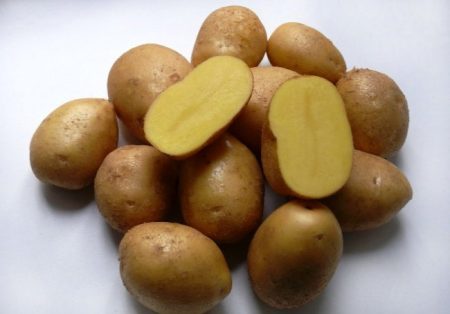 Breeding is constantly evolving, scientists are trying to develop the best varieties for vegetables or fruits, which will be resistant to the influence of climate, and not give in to diseases, and look good, and delight the taste of even the most fastidious gourmets. Potato Impala, description of the variety and photo, reviews became one of the results of long research, crossbreeding.
Breeding is constantly evolving, scientists are trying to develop the best varieties for vegetables or fruits, which will be resistant to the influence of climate, and not give in to diseases, and look good, and delight the taste of even the most fastidious gourmets. Potato Impala, description of the variety and photo, reviews became one of the results of long research, crossbreeding.
Main settings
Studying the characteristics for potato varieties Impala can be said that this variety ripens early, which pleases both large producers and ordinary summer residents. This saves time by allowing a better distribution of effort. He also has high resistance to various diseases, which, unfortunately, even vegetables have. Impala is considered a universal variety, ready to adapt and mature well in different climatic conditions, in different soil, while maintaining an attractive appearance and great taste.
• Peel - quite dense, but smooth, no roughness. It has a pronounced yellow tint.
• Eyes - medium or small, rare and superficial, extremely easy to clean.
• Pulp - shades from yellow to delicate cream.
• Shape - the tubers are often oval, sometimes round or middle between them.
• Starch - from 10 to 14.7%, average indicators.
• Average weight - most tubers are 90 to 160 g.
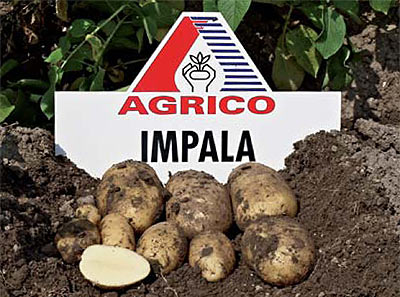
Impala is considered a table variety, which was first bred in the Netherlands (namely in the Netherlands). Yes, abroad they also actively grow and love potatoes. For its taste, unique qualities. After all, a vegetable can be safely added to soups, make a side dish and even sweet dishes. Recently, Impala is gaining more and more popularity precisely in Russia, apparently, local summer residents, vegetable growers and large producers have tried the variety and appreciated its quality. Cultivation can often be found either in the middle or in the southern part.
What distinguishes the Impala variety?
Early ripening - the first crop with proper care can be harvested by the 45th day, this is the time after planting, not sprouting, which is considered early ripening. Full ripening will come to 60-75 days, here you need to look at the climate, what summer will stand out, what soil. Often, to achieve a larger crop, potatoes are fertilized, but here it is worth clarifying the type of feed that is better suited.
Productivity - producers, simple summer residents appreciate and love the Impala for stability in terms of high yield. One bush gives about 15 tubers, these are medium or large, rarely small ones. But if the plantation is carefully looked after, their number increases to 17-21, then 1 ha of land given for potatoes will yield 37-60 tons. The southern regions sometimes collect as many as two crops, there is a long summer, early spring and many sunny days. Also, to increase the yield of this variety, we recommend using plant growth activator.
Drought tolerance - the potato is really able to adapt, it is not so afraid of an arid, hot, even stuffy summer. It tolerates moisture and moisture. True care is still important.
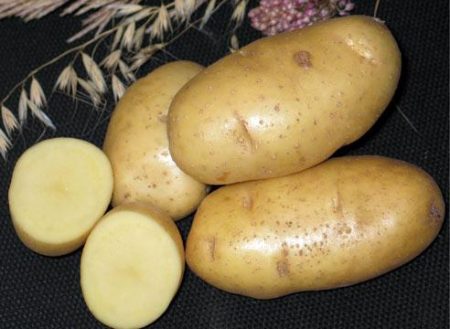
What soil is needed for growing vegetables - Most of all, Impala loves open ground, but in principle, it is able to grow everywhere. Sandy, clayy, too wet or too dry soils. Harvest still turn out and stably high. This also contributes to the spread of the Impala, especially among summer residents. Indeed, it is difficult for ordinary people to change the soil composition of their garden. It is expensive, time consuming. It is easier to find suitable varieties of vegetables or fruits, because any soil is good. For large producers, productivity and adaptability are also important, this reduces costs.
Destination - quietly transfers long storage, transportation.Surprisingly, the safety for tubers will be almost all 100%, even after extremely long storage! You can safely stock up Impala for the winter, even the northern one, where it lasts more than 3 months.
Taste - the taste of different varieties of potatoes is usually evaluated by a special jury. The tubers undergo the same treatment, then they are sampled. Impala, if evaluated on a standard five-point scale, will receive 4.9. Moreover, if you look at the external data after heat treatment, even a long one, the variety will also receive 4.9. The tubers retain their shape perfectly, remain pleasantly dense, the color pleases and low friability.
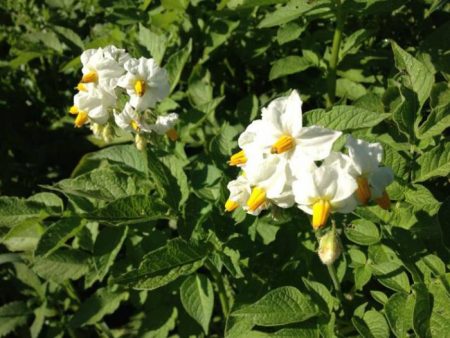
Mechanical damage - yes, it’s worth a look, because potatoes are not brought like crystal products, overlaid with newspaper or cotton balls. Sometimes the bags are simply thrown into the body, then they shake for a long time along the road or freeze in dark, freight wagons. Resistance to long, harsh transport is crucial. The less tubers get damaged, deteriorate, the more potatoes they can then sell. Impala shows himself extremely worthy. Potatoes usually retain up to 98% of their appearance, no matter how long or difficult the road is.
Diseases - alas, everyone, people, animals and even plants get sick. Potato as a species has a number of its diseases that every summer resident, vegetable grower or large producer must monitor, otherwise the yield will fall. Impala is not afraid of potato cancer, viruses A with Ah, also a nematode. It exhibits medium resistance when meeting with common scab, also late blight.
What shoots look like
The height of the bushes is somewhere 70-75 cm, tall, stand upright, appear on 4-5 stems, this makes the bush not only tall, but also moderately dense. When flowering, you can see beautiful, snow-white flowers with a yellow middle. The leaves are pleasant, saturated emerald color, they are medium in size and smooth, only a slight wave at the edges.
To deal with a variety of pests is as usual.
Prepare before boarding
Usually in the spring, preparatory work begins. The land is still cold, summer residents only clear areas, observe the melting of snow and prepare their planting materials. They plan how and where to plant types of vegetables. Places are usually occupied for many years.
Choosing tubers for subsequent germination, you need to carefully monitor the temperature for several days. In order for the germination to turn out to be of high quality, the degrees will be: + 18 ... + 25, etc., up to the time of planting, there already lower the temperature to + 12 ... + 14, increasing the illumination for tubers.
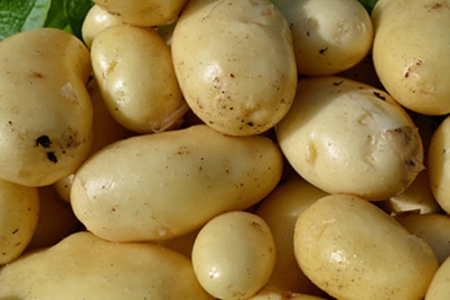
If you want to increase the number of eyes (small dots on the tubers), you need to make a banding - a transverse round, even incision, in the area closer to the top of the tuber.
When choosing an area for planting, places where legumes or winter crops previously grew, as well as perennial herbs, are better suited.
Processing the entire seed material exactly before planting has become a real fashion, moreover, they often use powerful chemical pesticides. Many believe this is a guarantee of a high yield, they say so the potato will be much more resistant to possible diseases. But in order to get the result as positive (and even safe), use not such harmful compounds. For example, treat with potassium permanganate or wood ash, possibly boric acid.
Recommended:Proper potato planting for a good harvest
You can whole box where there are already sprouted tubers in the prepared solution from potassium permanganate (1 g potassium permanganate itself will be in a bucket of water). Hold there for 30 or 40 minutes, then dust with wood ash. So you really increase the potato's resistance to disease.
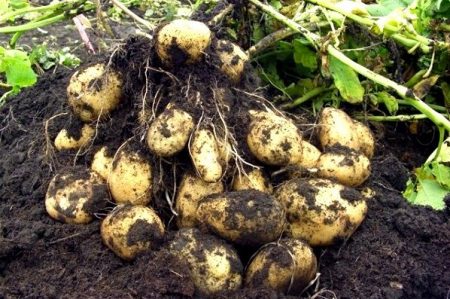
Important: adding ash to each planting hole sounds good when you plant your potatoes in spring. If you arrange the planting rows in the directions: north-south, north-west, south-east, then they will then receive uniform illumination by the Sun, this will increase the yield, increase starch in the tubers.
How to grow
The potato also does not like to constantly “live” in one place selected by it. it can not be planted in a place where there used to be nightshade, especially peppers, tomatoes, and also eggplant. Observe crop rotation.
Important: plant the Impala shallow in warm soil. So it’s faster to root and the tubers will turn out to be strong. After planting with a hoe, close up all the beds so that a soil ridge with a height of 7-10 cm is formed.
After surviving a week after planting, carefully carry out the harrowing, especially if it rained before that. Harrowing is more convenient to carry out a rake, processing ridges. This will destroy the filamentous weeds that have germinated and destroy the earth crust, which interferes with aeration. You can feed with fertilizers, for example, humus or mullein, bird droppings, covering them with a hoe directly into the ground, but it is better to fertilize after rain or good watering.
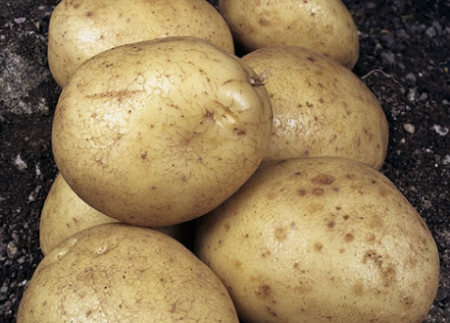
Irrigation measures are rare, but plentiful, water should not be spared. Either it will be good rain, or artificial irrigation, the main thing is to thoroughly wet the soil so that it passes up to 40 cm deep. If it doesn’t show enough rain, water next. Then for every 10 sq.m. it will take somewhere 400-500 liters of fluid. The interval of watering is 10 days, it comes out three times, if you look at the entire growing season.
After harvesting, Impala is kept as well as possible and will grow one of the last.
Yield increase
A few tips from experienced summer residents, vegetable growers who for many years cultivated it was Impala. Potato is certainly considered universal and is able to grow in any soil, but more like a quality fertilized, loose and well-moistened. It is also necessary to saturate the soil with humus, and the arable layer turned out to be deep.
Shoots appear faster when the temperature is + 18 ... + 25, and the potato blooms and its tubers are formed at + 17 ... + 20. If irrigation is assigned only to natural rainfall, then the maximum yield is given at a level of 50-300 mm of total summer rainfall, an important condition for the soil to be uniformly and abundantly moist.
In order to get two crops, you must first collect the early one, the first on cloudy days, picking the tubers, then plant each bush a second time, abundantly watering the holes. Such a trick will allow the Impala to form tubers by the time of the second, main crop.
Although the Impala was introduced only in 1995, it has already received general love and preference, especially from summer residents who love early ripe varieties. By cultivating in personal plots, people get an extremely early, good harvest from root crops, pleasing with a beautiful view.
Impala is even considered a sprinter, because he is gaining his weight well and will givegood potato cropno matter what the summer will be like.
Ordinary customers love Impala for its beautiful appearance, ease of cleaning and great taste. Potatoes are not able to boil even after long processing, for which professional chefs also love it.




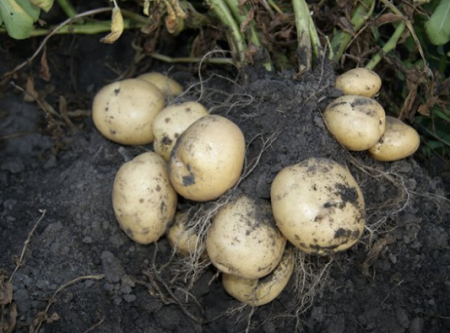
 Description and description of varieties in Belarus with a photo
Description and description of varieties in Belarus with a photo Do I need to pick flowers from potatoes: why do they do it
Do I need to pick flowers from potatoes: why do they do it When to dig potatoes: timing and availability of new potatoes
When to dig potatoes: timing and availability of new potatoes How to grow a good potato crop: various methods and methods, planting and care
How to grow a good potato crop: various methods and methods, planting and care